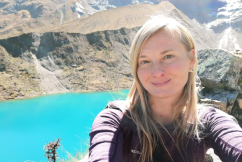An amazing turquoise colored glacier lake surrounded by towering glaciated peaks and valleys and offering breathtaking mountain views, even that of Salkantay Mountain, is a must-hike when in Cusco region.

From the bus.
Lake Humantay day hike is a wonderful way to explore the Peruvian Andes. Humantay is a glacier lake surrounded by some giants of the Andes such as Mount Salkantay and Mount Humantay. These towering, icy peaks provide a breathtaking scenery as if from a movie.
On the Trail.
Though the lake cannot be entered, you may touch the water for spiritual purposes. Many take their time to hike around the lagoon (especially to the other side of it) and to do rituals and ceremonies in the area.

Coca Leaves Ceremony – The Enduring Incan Tradition
One of the local traditions that has endured from the time of the Incas is the Pachamama Ceremony sometimes called Despacho. The Quechua word for this ceremony is Hariweequi, which means to offer with one’s own hand. The more commonly used name is Despacho, which in Spanish metaphorically means “to send in gratitude“. You will see people practicing it when going to the Rainbow Mountain or Machu Picchu as well as by Lake Humantay.
The Pachamama ceremony, or “Offering to the Mother Earth”, is a sacred ritual using the K’intus (sometimes Quintus, a “bouquet of three” symbolizing the Earth – the World Here, the World Below, The World Above) – usually three coca leaves (but possibly other items such as flower petals) – and other offerings such as candy, rice, anise, beans, peanuts, seeds such as huayruros, wool from llamas or vicuñas, sometimes even droplets of wine or sugar and incense which are placed onto a piece of white woven cloth. This practice is especially popular among businesses but even individuals and homes to ask for prosperity as well as protection, good luck, health or in order to get rid of bad energies.
The dedications of the offering are pronounced in Quechua to the direction of Hanan Pacha (the World Above), Kay Pacha (The World Here) and Uku Pacha (The World Below), while holding it high up towards the Sun God (Inti), the Sky God (Tayta) – often the Sun God and Sky God are referred to as one entity, Inti Tayta – and the Mountain Spirit (Apus) in both hands, with the stems pointing down to the Mother Earth. (There also is the Hakay Pacha, the World Beyond, but the dedications do not mention this world. The word Pacha stands for both time and space.)
Then, the offerings are given to the Earth – i.e. placed down on the ground. Here the ceremony differs from a practitioner to practitioner. Some would burn the offering while saying in their mind or whispering out their prayer, others would cover it by a pile of stones and pour pristine water over them.
When the ritual is over, everyone takes a minute in silent contemplation, sometimes chewing on coca leaves or drinking the remaining wine.

Every August 1st the Andean cultures worship Pachamama by following this indigenous tradition of the native peoples. The altomisayocs, Andean priests responsible for performing the ceremonies (and many other), are obliged to share their knowledge and lead those who wish to give back to the Great Mother.
How to get to the Lagoon
The easiest is to take a tour from Cusco (80 – 100 soles) which includes a morning pick up from your hotel (4:30 am), a three-hour drive, a breakfast (usually at Mollepata), a lunch after the hike and the transport back (around 4:30 pm). Obviously, a guide is present to help out with anything that might be needed.

Mollepata.
If you opt not for the steep two-hour hike (which forms a part of the Salkantay trek – more about it HERE – odkaz na článek Machu Picchu), you may take a horse up for 70 – 80 soles to save time and energy. The men from the local community will guide your horse so you do not need any prior experience horse-riding.

The beautiful Andean children.
To go down from the lagoon, you have to go by foot. It would be dangerous to go on horseback so this service is not offered.

Important Facts
To enter the lake zone you have to pay 20 soles (not included in the tour) to the local community as a foreigner, 10 as a Peruvian.
Remember to bring your mate de coca, as you will be at about 4,200 meters above sea level.
The best time to visit the lagoon is from April to October when it is the dry season, I would say generally June to August is the best.
Make sure to wear layers of clothes you can take off or put on as the weather in the zone can change from really hot to really cold.














